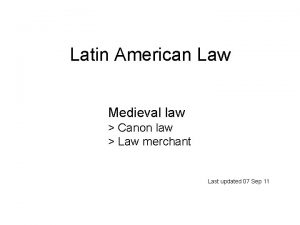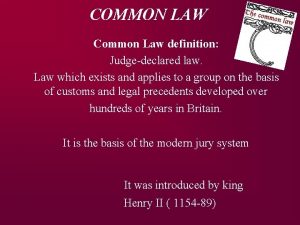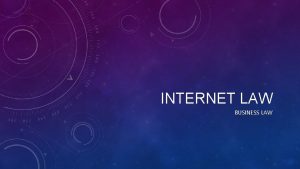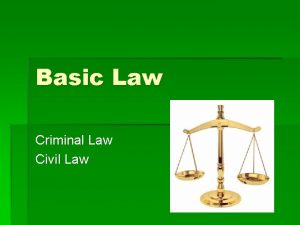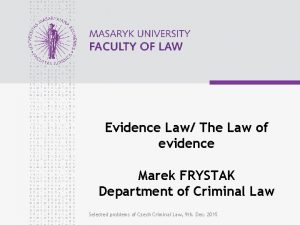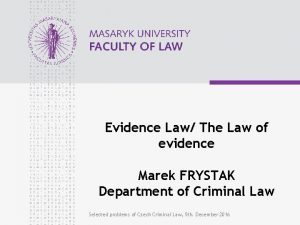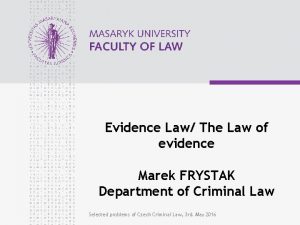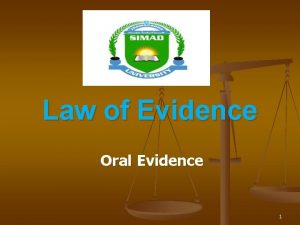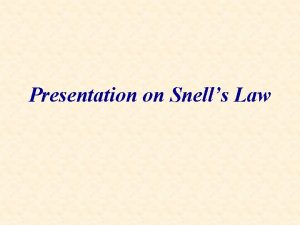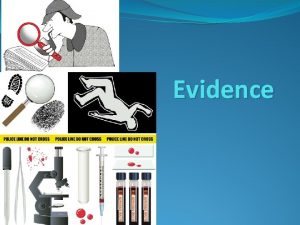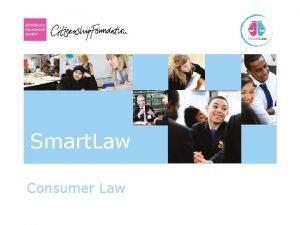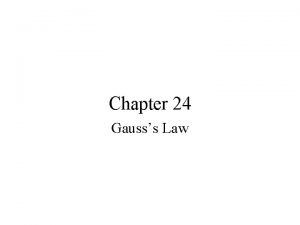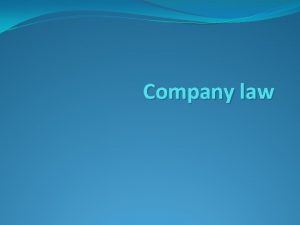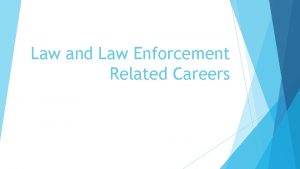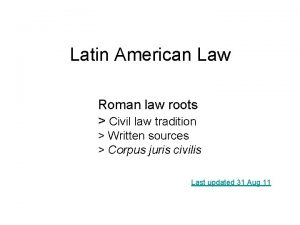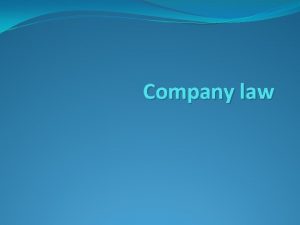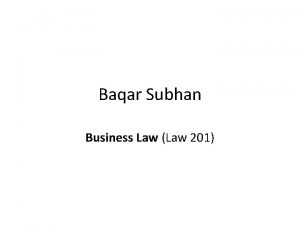Evidence Law 12 The Presentation of Evidence Evidence































- Slides: 31

Evidence Law 12

The Presentation of Evidence �Evidence presented by both the Crown and the defence must be presented in the form of witness testimony and exhibits. All evidence that is relevant, reliable, and fair is admissible. �The Crown presents their case first then the defence presents its case.

Arraignment �At the opening of a criminal trial, the charge read to the accused and the plea entered. �Must include the charge contained in the indictment (the formal written document charging an accused with a crime) �If the accused refuses to plead, a not-guilty plea is automatically entered on their behalf. �Justin Bieber’s Arraignment – Remember this is the US law

�Direct Evidence: The best evidence is usually obtained from a witness who actually saw the offence being committed.

�Circumstantial Evidence: though not as certain as direct evidence, can still be quite useful. For example, if a witness says she was standing outside a bank, saw a person run into the bank with a gun and a bag, heard shots, and then saw the same person run out of the bank, her evidence to the fact that a bank robbery occurred is valuable, but circumstantial in that she did not actually see the robbery committed. �The accused GENERALLY cannot be convicted on circumstantial evidence alone. Example: Steven Truscott was convicted of rape and murder purely on circumstantial evidence. � My Cousin Vinny � Aaron Hernandez – circumstantial case

�The examination-in-chief is the first questioning of a witness. No leading questions (a question which indicates the answer and generally leads to a “yes” or “no” response) are allowed since the Crown will have interviewed its witness when preparing. �Legally Blonde

�The defence lawyer may cross-examine a witness when the Crown has finished. Leading questions may be used at this time. Weighing of the evidence will require the judge or jury to determine which, of the one or more conflicting bits of evidence, is the most convincing. The credibility of witnesses is an important factor in this determination. Jodi Arias – cross examination

Disclosure of Evidence �Prior to a trial, the Crown must disclose all of its evidence to the Defence so that the accused fully understands the Crown’s case and so that a defence can be prepared. �The defence may disclose evidence or arguments that prove to the Crown that it does not have a case.

RULES OF EVIDENCE

� These have developed over many years and are quite complex (Canada Evidence Act). �A session without the jury is sometimes necessary to determine the admissibility of evidence - a voir dire (means: to see, to speak). �A witness is protected against the results of his/her testimony - self-incrimination (section 13 of the Charter of Rights & Freedoms) – evidence witnesses give in court must not be used against them later.

TYPES OF EVIDENCE

1. Privileges communications �Confidential communication that cannot be disclosed. �One spouse cannot be compelled to testify against the other, in most cases - privileged communication. Other examples are doctor/patient, clergy/church member, lawyer/ client. �However, a spouse may choose to give evidence for the defence. �Some exceptions apply, such as in crimes of violence against the spouse, certain crimes related to sex and some offences committed against minors.

2. Similar Fact Evidence �to show a past pattern of behaviour (often not admissible)

3. Hearsay Evidence �statements or writings by someone other than the witness (often not admissible) �must be necessary and dependable Drew Peterson: Murder wife #3

4. Opinion Evidence �Information based on the thoughts of the witness, usually an expert

5. Character Evidence �difficult for the Crown to get admitted since the jury is supposed to decide on the basis of facts only. �Witnesses can be questioned about their previous history to verify their credibility. �The accused can be questioned this way only if he takes the stand.

6. Photos �judge determines admissibility since some act merely to inflame the jury.

7. Interception devices and video surveillance �private conversations can be intercepted only if one party consents, or by court order. �a potential victim of violence (e. g. spousal abuse or stalking, can authorize police) Robbery Surveillance

8. Polygraph evidence �In a polygraph (lie detector) test, a person is asked questions while hooked up to a machine that measures changes in blood pressure, respiration, and pulse rate to indicate whether the person is telling the truth. �Supreme Court of Canada has ruled polygraph tests are hearsay and therefore inadmissible as evidence.

9. Confessions �inculpatory: an admission �exculpatory: a denial �one given without being told of the right to counsel, may be inadmissible. �also those given under duress, involuntarily or with a promise of leniency jailhouse confessions often questionable. �The admission of illegally obtained evidence has been the subject of huge debate since the Charter was passed Will Ferrell – Interrogation room – skip to 1 min

Textbook- Confirm and Demonstrate your Knowledge �Read pages 193 -200 �Case: R. v. Dhillon (2001) pg. 199 �Questions 1 -6 pg. 201 Due Monday: Discussed in class (checkmark in Powerschool) Find the textbook that was assigned to you and be sure to bring it home.

Witness Testimony � (CNN)Witnesses talk about wiseguys, rats and hiding bodies, and list the do's and don'ts of organized crime. A tattoo on the defendant's arm reads "Death before dishonor. " Peppered into riveting testimony are nicknames like Skinny Dom, Vinny Gorgeous, Louie Haha and Tommy Shots. � If it sounds like a Hollywood movie script, it kind of already is. � But this is real life and at the center of it all is 80 -year-old Vincent Asaro -- the alleged former mob captain who's on trial in federal court to face charges in a string of crimes over 40 years. Among them: murder, racketeering and the famed 1978 Lufthansa heist at JFK International Airport that helped inspire part of the plot in the 1990 film "Goodfellas. " � In opening statements as the trial got under way Monday, Assistant U. S. Attorney Lindsay Gerdes called Asaro a "gangster through and through, " who, as a captain in the Bonanno crime family, lived his life according to the Omerta -- organized crime's "code of silence. " � Two witnesses have been called so far who have chosen to break that code: Sal Vitale, a Bonanno underboss who has pleaded guilty to participating in 11 mob -related murders, and Gaspare Valenti, a cousin of Asaro and a Bonanno associate. Both have signed cooperation agreements with the government.

Sexual Assault/ Predator �Oftentimes witness testimony is vital to the conviction of an individual up on these charges. �It is notoriously difficult to prove, but there is power in numbers. �This kind of testimony is emotional and relies on the first person account of direct witnesses.

Witness Pros Cons Physical/ Forensic

Debate- Witness vs. Physical Evidence �You will form groups of 6. � 3 of you will be arguing that witness testimony is more valuable. � 3 of you will be arguing that physical evidence is more valuable. �There is a format sheet provided.

Recording Your Debate �When you are ready you will fill in the chart on the handout as to who is doing what. �Make sure everyone is clear on their role and listen attentively to the arguments made. �If there are no rebuttals or challenges then it is not a proper debate and your mark will go down. �Make sure to record the number of the ipad that you are using so that I can listen to it after school today.

Mark �Your mark will be based on: �Power of Information and vocab (from textbook and notes) (4) �Ability to Rebut an argument and challenge the speaker effectively and respectfully. (4) �Persuasive Abilities (lawyers lose their cases when they are unclear and do not speak dynamically (4)

ENTERING AN EXHIBIT INTO EVIDENCE

�Every exhibit must be introduced through an appropriate witness who can identify it and tell the court what connection the exhibit had with the crime. Example: �Q: “ I am showing you a document/item/object/photograph. Do you recognize it? ” � A: “Yes. ”

�Counsel will introduce the exhibit in the course of examining the witness. Often counsel must establish a chain of control by having all witnesses who handled an exhibit testify. Where necessary, ask questions regarding the continuity of the evidence. For example: �What happened to it over time, from place to place �Who handled it �How was it packaged/transported?

�Example: “What did you do with _____ once you recovered/found/obtained it? ” �When entering an exhibit counsel should state, “We wish to enter this (name item) as an exhibit. ” (Hand the item to the court clerk. ) �** This is very important to ensure that the item is introduced to the court and that the judge will be able to rule on the admissibility of the evidence.
 Newton's first law and second law and third law
Newton's first law and second law and third law Si unit of newton's first law
Si unit of newton's first law Boyles law
Boyles law How to calculate boyle's law
How to calculate boyle's law Hình ảnh bộ gõ cơ thể búng tay
Hình ảnh bộ gõ cơ thể búng tay Bổ thể
Bổ thể Tỉ lệ cơ thể trẻ em
Tỉ lệ cơ thể trẻ em Gấu đi như thế nào
Gấu đi như thế nào Tư thế worm breton
Tư thế worm breton Bài hát chúa yêu trần thế alleluia
Bài hát chúa yêu trần thế alleluia Môn thể thao bắt đầu bằng từ chạy
Môn thể thao bắt đầu bằng từ chạy Thế nào là hệ số cao nhất
Thế nào là hệ số cao nhất Các châu lục và đại dương trên thế giới
Các châu lục và đại dương trên thế giới Cong thức tính động năng
Cong thức tính động năng Trời xanh đây là của chúng ta thể thơ
Trời xanh đây là của chúng ta thể thơ Mật thư anh em như thể tay chân
Mật thư anh em như thể tay chân 101012 bằng
101012 bằng Phản ứng thế ankan
Phản ứng thế ankan Các châu lục và đại dương trên thế giới
Các châu lục và đại dương trên thế giới Thơ thất ngôn tứ tuyệt đường luật
Thơ thất ngôn tứ tuyệt đường luật Quá trình desamine hóa có thể tạo ra
Quá trình desamine hóa có thể tạo ra Một số thể thơ truyền thống
Một số thể thơ truyền thống Cái miệng bé xinh thế chỉ nói điều hay thôi
Cái miệng bé xinh thế chỉ nói điều hay thôi Vẽ hình chiếu vuông góc của vật thể sau
Vẽ hình chiếu vuông góc của vật thể sau Biện pháp chống mỏi cơ
Biện pháp chống mỏi cơ đặc điểm cơ thể của người tối cổ
đặc điểm cơ thể của người tối cổ Ví dụ về giọng cùng tên
Ví dụ về giọng cùng tên Vẽ hình chiếu đứng bằng cạnh của vật thể
Vẽ hình chiếu đứng bằng cạnh của vật thể Tia chieu sa te
Tia chieu sa te Thẻ vin
Thẻ vin đại từ thay thế
đại từ thay thế




































